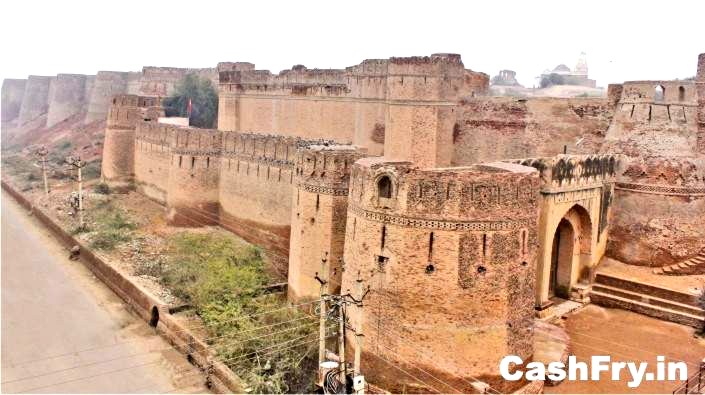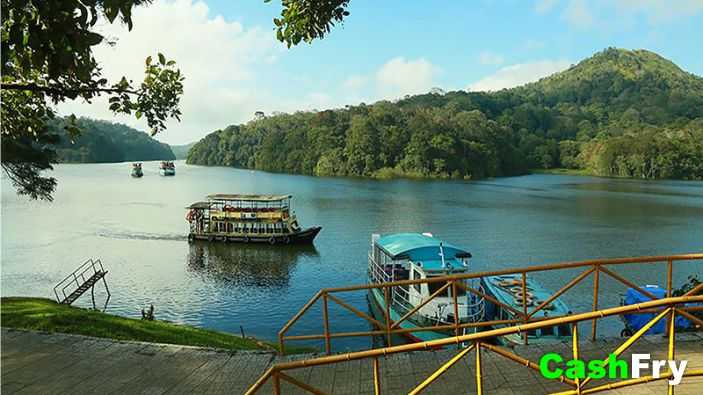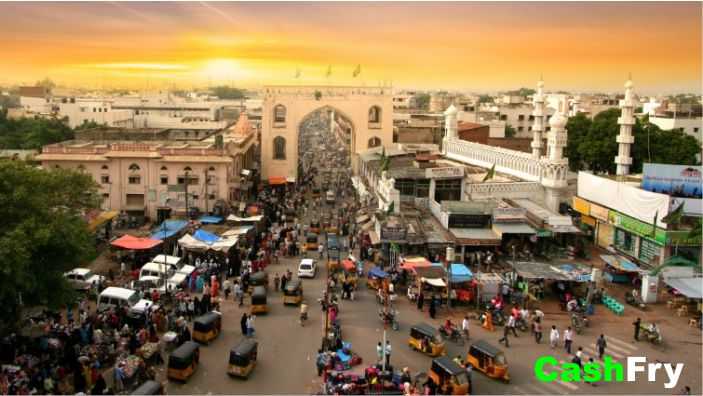Gangtok Sightseeing
God created a heaven near the Himalayas and that is Gangtok. You can see the Gold Mountains of Kanchenjunga during the morning dawns, beautiful lakes, simple loving people all around the city. You can eat Momos, Chowmein, and other delious food in the restaurants of Gangtok.
Go for Gangtok Sightseeing and you will never regret. There are plenty of wonderful places to visit in Gangtok. If you go by your own vehicle, that is best because you can stop anywhere and enjoy some snacks or drinks. There are great simple people all around. We are giving here the details about the various tourist places in Gangtok and the way, how to reach Gangtok.
Best Seller Amazon Products
How to reach Gangtok? :
You can reach New Jalpaiguri by train from Delhi or any place. You can take a local conveyance, Taxi, Bus from New Jalpaiguri to Gangtok. Alternatively, you can book a flight from Delhi to Gangtok. You can book your hotel and flight at the discounted price with Yatra Coupons at CashFry.in. Gangtok sightseeing can be as thrilling as a foreign place. It is an all neat and clean city.
You can check out the Video about Gangtok Tourist Places:
Before you read about Gangtok you must check out Why Summer Holidays in Hills? in this Blog. The Best Hill Stations in India. The major tourist places in Gangtok are:
Tsomgo Lake :
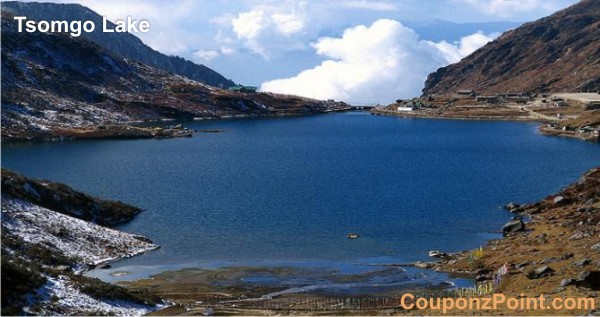
Tsomgo Lake is situated 35 km far from the city on the Gangtok Nathula roadway. This expressway is additionally a part of the old route that connects India and China. Loved by Sikkimese, this sacred lake is roughly 20 km far from the Nathula Pass. It is situated at a distance of around 400 km from Lhasa. Lhasa is in China. It is one of the best places to visit in Gangtok.
The water in this lake comes from the melting of snow on the mountains surrounding the lake. The stream Lungtze the Chu starts from this lake, which meets Rangpo-chu down its course. As per the history, the shade of water of this lake was contemplated by Lamas in order to gauge about the future of the state. They accepted, if the water had a dim tinge, it showed a year loaded with inconvenience and distress in the state.
Tsomgo Lake is situated in the confined zone for which the travelers require an Inner Line Permit for the Sightseeing. This permission can be gotten from the Police through the travel operator or Tourism Department. Amid the winter months, the whole lake gets frozen.
Voyagers can likewise witness a small temple devoted to Lord Shiva based on the lakeside. What’s more, around the Tsomgo lake, primula blossoms and other alpine plants and trees have developed. Visitors can likewise go for a walk on the trail along the lake, which prompts a resting shed situated at a distance of around half a kilometer from the lake.
The best time to visit this lake is from March to late May and from October to mid-December. You can book your flight and Hotel through Make My Trip at the discounted price by using ClearTrip Domestic Flight Coupons
Menmecho Lake :
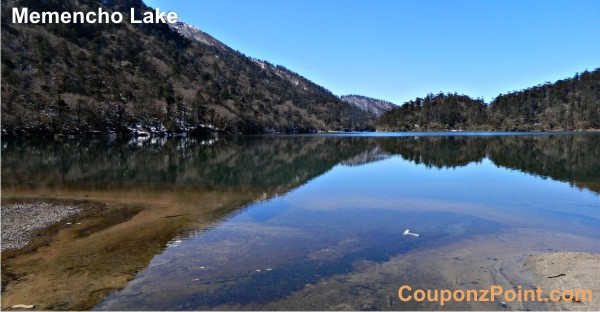
Menmecho Lake is on the way to Jelepla Pass and is located at a distance of 20 Km ahead of Tsomgo lake. There is a river Rangpo chu which feeds this lake. This river is tributary of the Teesta River. The lake gets filled with water from melting of the snow from mountains of Jelep La Pass in summer.
The lake is noted for freshwater fish. It has got a large fish farm nearby with a guesthouse. Menmecho area is sealed and tourists cannot go there. To visit this lake you have to take special permission from the Indian defense. You can check out accommodation near Memencho Lake. This is a bungalow with just four rooms at 10 minutes walk from the lake. As earlier said you would require special permits to reach this bungalow and the lakeside. The road leading to this lake is under the guard of the Indian Army.
Some people call it Memencho Lake also. It is one of the most amazing lakes of Sikkim. It is situated at an altitude of 13000 feet. There are pine forests and deep slopes. Memencho Lake changes colors every minute. It stays frozen from January to May. There is a narrow winding road 4 kilometers long beside Baba Mandir which takes you to Memencho Lake. There is some newly built rough motorable road also.
Best Deals on Amazon
The river has got sandy banks which gives the appearance of a sea beach. The pine forests are inhabited by Ghorals and Himalayan Bears. You can see the migratory birds resting on these placid waters just before November. You really need to stay for a night in this bungalow to witness some of the amazing moments of your life. Please do not get scared. There is a staff in the bungalow and you would simply enjoy an unforgettable time.
Just imagine it is a moonlit night. You are sitting on the terrace of the bungalow amidst deep forests. You can hear the soothing sound of the lake water lapping on its shores. The swirling gust of winds blows through forests and canyons making a mysterious sound. The rolling sand around the lake looks like a silver lace. Just stay for a night and enjoy the local delicacies. You can visit Memencho Lake from 31st May to 1st December. Rest of the year there is heavy snowfall and the road is not motorable.
Nathula Pass :
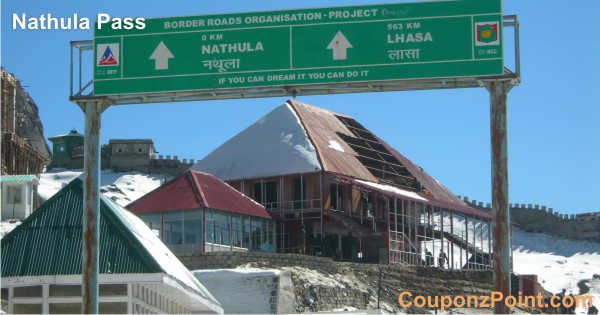
Nathula Pass is situated at a distance of 56 Kms from the city of Gangtok. This is located on the Indo Chinese border. This pass served as a trade link between India and China; and between India and Tibet. This pass is at the level of 14450 feet and is popularly known as the Silk route. All area is rich in alpine flora and fauna. ‘Nathula’ means Nathu + La listening ears. This trade route was closed down in 1961 during and after the war. In 2006, the route was reopened again. There is Tsomgo Lake on the way. That is why this pass is among the highest motorable roads. This pass remains covered with snow most parts of the year. Therefore, it requires special permission to visit Nathula.
You can visit the Nathula Pass Wednesday, Thursday, Saturday, and Sunday. Due to Nathula Pass, you have to travel less to visit the pilgrimage sites such as Lhasa and Mansarovar Lake.
Himalayan Zoological Park :
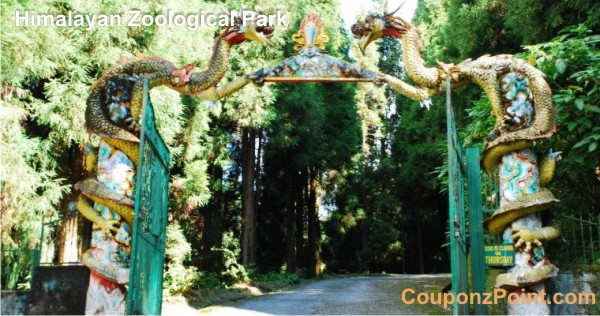
There is Himalayan Zoological Park located at a distance of 3 km from Gangtok. This park is among the best places for wildlife lovers. This is situated in Bulbuley. This park has been set up in 1991 with the aim to protect wildlife in a natural way. This park is sprawled over an area of 500 acres and is 1780 meters above the sea level. You can view Mount Kanchenjunga from this point.
It is among the few specialty parks in India. Here animals are kept in replicated natural conditions. Most part of this Zoological Park is covered with forests meant for Red Panda, Musk Deer, Blue Sheep, Barking Deer, and Himalayan Black Bear.
There are hedged open-air enclosures in the park. These enclosures are the habitats for Red Pandas, Leopard Cat, Barking Deer, Panther, Barking Bear, Himalayan Palm Civet, and Tibetan Wolf. Also, the tourists can spot Goral Spotted Deer and Bears.
The best time to visit this park is February mid to May and September mid to December.
Rumtek Monastery :
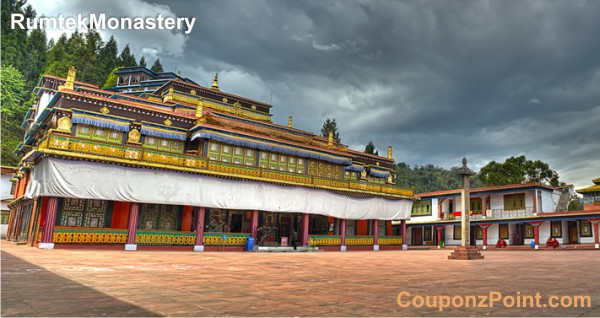
There is a world famous monastery ‘Rumtek’ situated 24 Km from Gangtok. Rumtek is the most important Site for every Buddhist. This was built in the 16th century during the reign of the 4th King of Sikkim. This monastery was completely damaged due to fire in the late 1960s. After that, a new monastery was rebuilt. It was named as Rumtek Dharma Chakra center. There is the main shrine temple as well as the quarters of monks. A Golden stupa is there inside the monastery. This stupa has old objects of 16th Karmapa. Many Tibetan festivals such as Tse-Chu Chaam, Kagyat Dance are celebrated at Rumtek throughout the year.
Ganesh Tok :
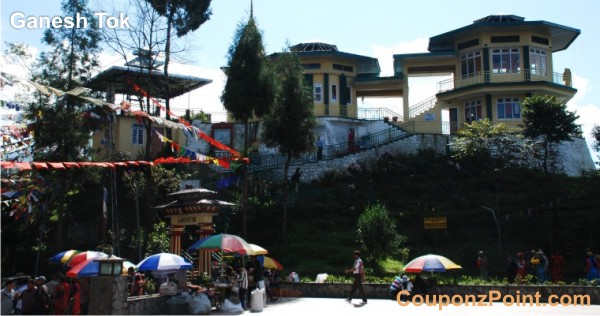
Ganesh Tok is a small temple situated at a distance of 7 kilometers from Gangtok. It is located next to the television tower on a small hill situated on the Gangtok-Nathula road. As the name indicates, the temple is devoted to Lord Ganesha. This temple is very small in size and it does accommodate more than one person. Also one has to crawl to get into the temple. This temple is also known for the bird’s eye view of many places like Gangtok town, Kanchenjunga and Raj Bhawan Complex. There is a Smriti Van near the temple where people can plant trees.
Tashi View Point :
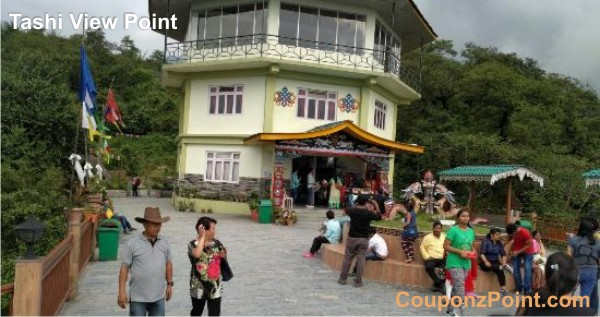
There is a Tashi View Point 4 Km away from Gangtok. It was constructed by Tashi Namgyal, the King of Sikkim. At this viewpoint, there is a park. This viewpoint is the best place to view Mount Kanchenjunga. You can also view the Phodong Monastery and the Labrang Monastery situated on the opposite side of the hills. There is a shed and a cafeteria to sit and rest.
Hanuman Tok :
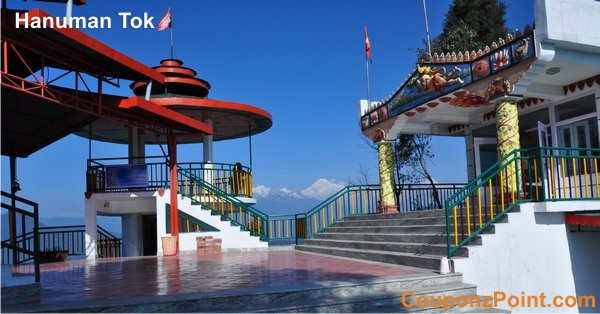
Hanuman Tok is a temple of God Hanuman located 5 Kms from White Hall. It is situated at Gangtok- Nathula highway. It is one of the most popular temples in Gangtok. It is maintained by the Indian Army. It is made at a high point from where you can view Gangtok as well the other nearby hills.
Ban Jhakri Falls :
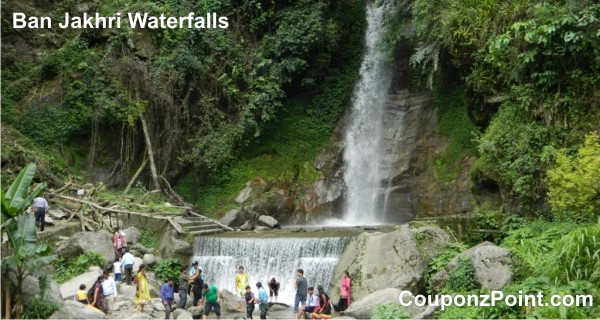
Ban Jhakri Falls is located 4 Kms from the Gangtok city. Waterfalls from a height of 70 feet. There are lush green surroundings. Energy Park is also built and maintained here.
Jhakris is the supernatural powers to heal the sick. Near the waterfalls, there is a park filled with ethnic sculptures and figures of the Jhakris who are seen healing the sick. The ethnic tribes of Sikkim have a lot of faith in Jhakris. Jhakris can influence the spirits to bring about good and bad.
There are a dragon splash and a footbridge built over the water stream which are other two major attractions of this park.
There is a Ranka Monastery situated on the route to the falls. The best time to visit this spot is between October and February.
Jawaharlal Nehru Botanical Garden :
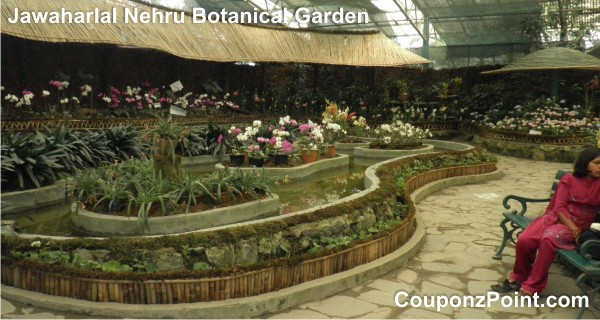
The government of Sikkim established Jawaharlal Nehru Botanical Garden in 1987. JNBG is home to several types of botanical species. This garden is located near Rumtek Monastery. There are unique flowers, plants, and trees. Plenty of Orchids of the Himalayan region are there. This Garden is maintained and managed by the Forest Department of the Government of Sikkim. In the garden, there are dense forests of Oak trees. There are plenty of varieties of tree species in the garden.
For children, there is a small recreational center in the garden which is equipped with swings, see-saw, and merry-go-round.
The best time to visit this garden is from March to May end and from October to mid of December.
Ranka Monastery :
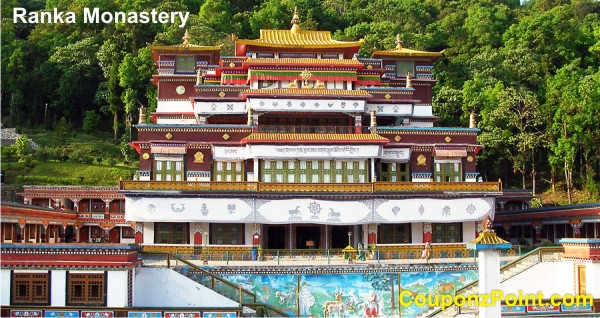
Ranka Monastery is a popular Buddhist monastery situated in Lingdum about 13 km from Gangtok city. Local people call it Lingdum monastery also. It is run by the Sikkimese Gharwan Rimpoche. This monastery has a state of art architecture and aesthetic values. There is a collection of various Tibetan paintings. These paintings are called Thangkas. Visitors come to the monastery and spin the row of prayer wheels for their good luck. There is a statue of Buddha sitting in the lotus position inside the shrine.
It is open to all religions, caste, color, and creed. Anybody can happily explore the entire periphery of the monastery. Buddhist monks perform Lama dance during Tibetan New Year. They sing songs during the evening prayers. You can take a ride on the popular ropeway. Also, you can visit Rumtek which is nearby.
There are plenty of shared taxis available for this place.
There is an exotic view of the sunset behind the Kanchenjunga range. You can do photography.
Bakthang Waterfalls :
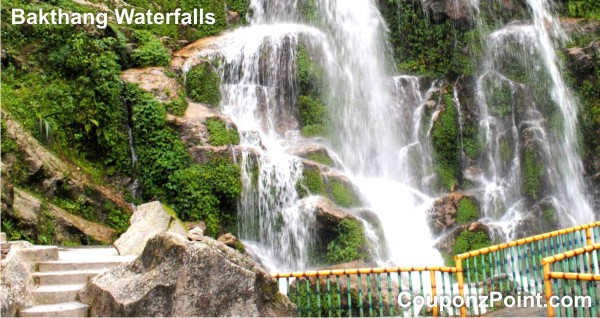
The Great beauty of Gangtok is Bakthang waterfalls. It emerges from Ratey Chu river. Bakthang waterfalls are among the best natural attractions of Gangtok. Ratey Chu is the main source of water to the city. It is a fascinating scenic beauty of the mighty Himalayas. The great picturesque mountains in the background and the bird’s eye of the nearby places make the frosting on the cake.
Bakthang is 20 minutes drive from the city. Absolutely a great place for nature lovers and photographers.
Do Drul Chorten Stupa :
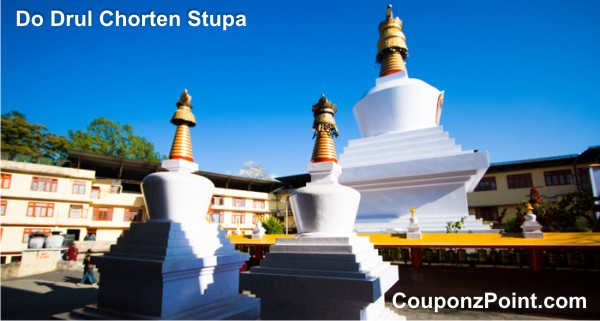
Do Drul Chorten is located only 2kms from Gangtok Town in Deorali area. It is the biggest stupa in Sikkim. It is situated on the hillock near the Research Institute of Tibetology. This stupa was built in 1945. It is popularly known as Phurba because the deity ‘Dorjee Phurba’ enshrined on top of the Chorten stupa. Some people call it Vajra Kilaya also.
There is a golden top dome at the Chorten Stupa. You can see this golden top from many places in Gangtok. Many people believe that this all area was once dwelled by the evil spirits. Many people who roamed around, suffered and died. Later Trulshig Rinpoche, one of the most respected and celebrated lamas of Tibet came to this place. He took the initiative to build this stupa in 1946, so that the evil spirits may go away. It is a huge place; can easily accommodate about 700 monks at a time.
There are 108 prayer wheels surrounding the stupa. All the wheels are engraved with holy inscriptions and mantras on them in the Tibetan language. If anybody should rotate the prayer wheels, should rotate in clockwise direction. There are Kanjur holy books, antiques, mantras and many other religious items.
There is a small stupa named Jhang Chup Chorten nearby. It was built in the memory of Trulshig Rinpoche after his death.
This stupa is in white in color, a symbol of peace.
Yumthang Valley :
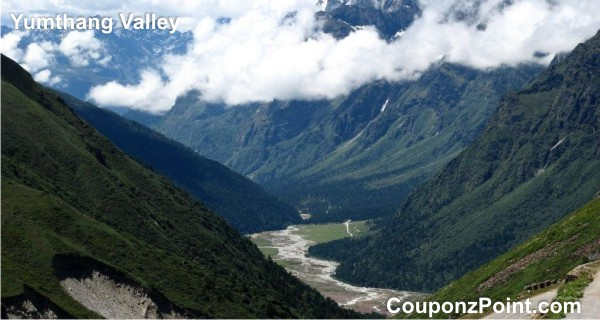
Yumthang Valley is located in the north of Sikkim. This beautiful valley is at the height of 3500 meters from the sea level. There are plenty of Himalayan flowers. This is the place where you can soothe your senses with the gorgeous sight of beautiful flowers. It is absolutely a picturesque view.
There are trees along the slopes of Yumthang Valley. There is a river of crystal clear water flowing through the slopes. There is a number of yaks grazing the grassy plants across the valley. There is tranquillity, unforgettable ambiance and serenity which makes the valley one of the most peaceful place to relax and enjoy. In the season of monsoons, you can see the tiny Himalayan flowers such as Primroses, Louseworts and Cobra Lilies. It adds beauty to the grandiloquent place. It looks like a painted collage of distinct colors.
Seven Sister Waterfalls :
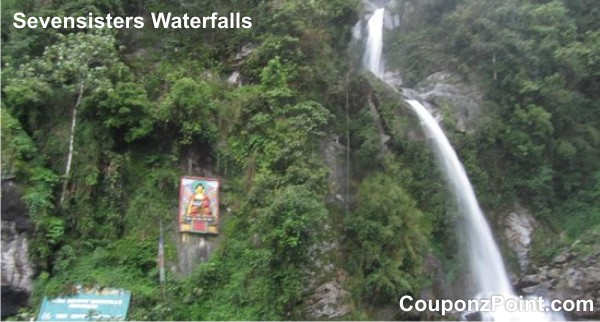
Seven Sister Waterfalls is located 32 km away from Gangtok. Anybody who visits Gangtok must visit this place. There are seven waterfalls aligned side by side one after the other. It is a wonderful sight to view. In the season of Monsoon, these waterfalls come to an intense life. Tourists stop at a distant place to enjoy flourishing nature. There are a shed and cafeteria for the tourists to take a break and do photography.
Hope you have liked this article regarding Gangtok Sightseeing and the places to visit in Gangtok. You can also check out 10 Best Places to Visit in Summer






